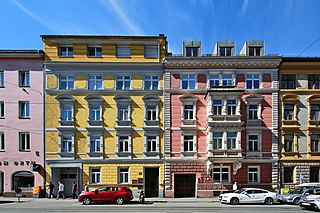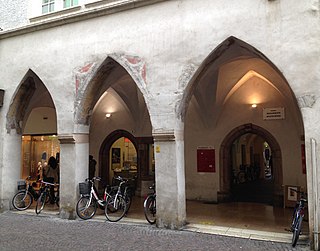Related Research Articles

Innsbruck is the capital of Tyrol and the fifth-largest city in Austria. On the River Inn, at its junction with the Wipp Valley, which provides access to the Brenner Pass 30 km (19 mi) to the south, it had a population of 132,493 in 2018.

During World War II, Braunschweig was attacked by Allied aircraft in 42 bombing raids. On the night of 14/15 October 1944, the attack by No. 5 Group Royal Air Force (RAF) marked the high point of the destruction of Henry the Lion's city during the war. The air raid was part of Operation Hurricane, which was designed to demonstrate the capabilities of the Allied bombing campaign. The attack caused a massive conflagration, that might have developed into a firestorm, and resulted in Braunschweig burning continuously for two and a half days from 15 to 17 October. More than 90 percent of the medieval city centre was destroyed, changing the city's appearance to the present day.

Urbanus Henricus Rhegius or Urban Rieger was a Protestant Reformer who was active both in Northern and Southern Germany in order to promote Lutheran unity in the Holy Roman Empire. He was also a popular poet. Martin Luther referred to him as the "Bishop of Lower Saxony".
This order of battle lists the German, Hungarian, Romanian, and Soviet forces involved in the Battle of Debrecen in October 1944.

Philipp Sarlay, also named Filipp Sarlay was an Austrian principal of telegraph office of Austrian-Hungarian origin and a pioneer in technological and scientific accomplishments. He was a follower of naturopathy, abstainer and vegetarian. Furthermore, he was occupied by studying mathematical phenomena

Heinrich or Heinz Andergassen was an engineer, SS officer, and convicted war criminal who was executed for the torture and murder of seven Allied prisoners of war. He was a SS-Sturmscharführer and later an SS-Untersturmführer in Northern Italy.
Gerhart Hass was a German historian. His approach reflected the Marxist prism through which East Germany's historical establishment viewed their subject. He worked at the History Institute, part of the Berlin based (East) German Academy of Sciences and Humanities, where from 1974 he was a professor. His work concentrated on the History of Fascism in Europe and the Second World War.

The Civic Archives in Bozen-Bolzano are the municipal archive of the city of Bolzano in South Tyrol, Italy. They are located in the old town hall and store documents from over 700 years of civic and regional history.
The LXVI Army Corps, initially known as the LXVI Reserve Corps, was an army corps of the German Wehrmacht during World War II. The corps was formed in September 1942.
The LXXI Army Corps, initially known as Higher Command LXXI or Höh.Kdo. röm. 71, was an army corps of the German Wehrmacht during World War II. The corps was deployed in March 1942. Throughout the war, it was stationed in the north of occupied Norway.
The LXXII Army Corps was an army corps of the German Wehrmacht during World War II. The corps was formed in February 1944. Before October 1944, it carried the designation z. b. V., marking it as a corps 'for special deployment'.
The LXXIV Army Corps was an army corps of the German Wehrmacht during World War II.
The LXXXI Army Corps was an army corps of the German Wehrmacht during World War II. The corps was established in occupied France in 1942 and remained active until 1945.

The LXXXIII Army Corps was an army corps of the German Wehrmacht during World War II. It was formed in 1942 and existed until 1943. After its dissolution, the personnel of the LXXXIII Army Corps was used to form the staff of the new 19th Army.

The LXXXV Army Corps was an army corps of the German Wehrmacht during World War II. The corps existed between 1944 and 1945 and had been preceded by a formation known as Group Knieß between 1943 and 1944.

The LXXXVII Army Corps was an army corps of the German Wehrmacht during World War II. It was formed in 1942 and existed until March 1944.

The LXXXVIII Army Corps was an army corps of the German Wehrmacht during World War II. It was formed in 1942 and existed until 1945.
The 270th Infantry Division was an infantry division of the German Heer during World War II.
Willi Alfred Boelcke was a German Economic and Social Historian, journalist, prolific author, essayist and retired university professor. The focus of his research and output has been on Germany during the nineteenth and twentieth centuries.
The 544th Volksgrenadier Division was a Volksgrenadier-type infantry division of the German Wehrmacht during World War II. It was active from July 1944 to May 1945. In the first two months of service, the division was designated 544th Grenadier Division.
References
- Albrich Thomas; Gisinger Arno: Im Bombenkrieg – Tirol und Vorarlberg 1943–1945. Innsbruck: Haymon Verlag 1992 (Innsbrucker Forschungen zur Zeitgeschichte, Vol. 8).
- Arnold, Konrad (Hrsg.): Luftschutzstollen aus dem Zweiten Weltkrieg. Das Beispiel Innsbruck. Von der Geschichte zur rechtlichen und technischen Problemlösung in der Gegenwart. Innsbruck: Studienverlag und Stadtarchiv/Stadtmuseum Innsbruck 2002 (= Veröffentlichungen des Innsbrucker Stadtarchivs, Neue Folge, Vol. 27).
- Die Bombenangriffe auf Innsbruck in den Jahren 1943 bis 1945. In: Tiroler Heimatblätter, Vol. 3/4, 1947–1948, pp. 60–61.
- Ingenhaeff, Wolfgang; Bair, Johann: Die Erinnerung bleibt. Tirol im Bombenkrieg 1943 bis 1945. Innsbruck, Wien: Berenkamp 2004.
- Innsbruck hilft sich selbst. Die Landeshauptstadt Tirols bei Kriegsende und zwei Jahre später. Ein Bild-Dokument aus schwerer Zeit mit 65 Photos und Zeichnungen. Innsbruck: Stadtmagistrat 1947.
- The June 13, 1944, Mission to Innsbruck, Austria. In: The Torretta Flyer. Winter Spring 1995, No. 27, pp. 18–32.
- Schreiber, Horst: Innsbruck im Bombenkrieg. Der historische Hintergrund de Stollenbaues. In: Konrad Arnold (Hrsg.): Luftschutzstollen aus dem Zweiten Weltkrieg. Das Beispiel Innsbruck. Von der Geschichte zur rechtlichen und technischen Problemlösung in der Gegenwart. Innsbruck: Studienverlag und Stadtarchiv/Stadtmuseum Innsbruck, Innsbruck-Vienna-Bozen 2002 (= Veröffentlichungen des Innsbrucker Stadtarchivs, Neue Folge, Vol. 27), pp. 15–98.
- Michael Svehla: Als in Innsbruck die Sirenen heulten. Luftangriffe 1943–1945. Innsbruck: Universitätsverlag Wagner 2019 (= Veröffentlichungen des Innsbrucker Stadtarchivs. Neue Folge, Vol. 67).
- Trapp, Oswald: Die Kunstdenkmäler Tirols in Not und Gefahr. Bericht des Landeskonservators über die Geschehnisse in den Jahren 1938–1945. Innsbruck, Wien: Roher 1947.
- Unterrichter, Leo: Die Luftangriffe auf Nordtirol im Kriege 1939–1945. In: Veröffentlichungen des Tiroler Landesmuseums Ferdinandeum 26/29 (1946/49), pp. 555–581.
- Zimmermann, Adolf: Alte Stadt im Ungewitter. Tatsachenbericht eines alten Innsbruckers. Innsbruck: Selbstverlag 1949.